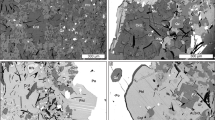Abstract
The Tono sandstone-type uranium mine area, middle Honsyu, Japan is composed of Miocene lacustrine sedimentary rocks in the lower part (18–22 Ma) and marine facies in the upper part (15–16 Ma). Calcite and pyrite occur as dominant diagenetic alteration products in these Neogene sedimentary rocks. The characteristics of calcite and pyrite differ significantly between lacustrine and marine facies. Abundant pyrite, calcite, organic matter, and small amounts of marcasite or pyrrhotite occur in the lacustrine facies, whereas small amounts of calcite and framboidal pyrite, organic matter and no marcasite or pyrrhotite are found within the marine units. The δ13C values of calcite in the lacustrine deposits are low (−19 to −6‰ PDB) but those in marine formation are high (−11 to +3‰). This implies that the contribution of marine carbonate is larger in upper marine sedimentary rocks, and carbon in calcite in the lower lacustrine formation was derived both from oxidation of organic matter and from dissolved marine inorganic carbon. The δ34S values of framboidal pyrite in the upper marine formation are low (−14 to −8‰ CDT), indicating a small extent of bacterial seawater sulfate reduction, whereas those of euhedral-subhedral pyrite in the lower lignite-bearing arkose sandstone are high (+10 to +43‰), implying a large extent of closed-system bacterial seawater sulfate reduction. The δ34S and δ13C data which deviate from a negative correlation line toward higher δ13C values suggest methanogenic CO2 production. During diagenesis of the lacustrine unit, large amounts of euhedral-subhedral pyrite were formed, facilitated by extensive bacterial reduction of seawater sulfate with concomitant oxidation of organic matter, and by hydrolysis reactions of organic matter, producing CH4 and CO2. Uranium minerals (coffinite and uraninite) were also formed at this stage by the reduction of U6+ to U4+. The conditions of diagenetic alteration within the lacustrine deposits and uranium mineralization is characterized by low Eh in which nearly equal concentrations of CH4 and HCO3 − existed and reduced sulfur species (H2S, HS−) are predominant among aqueous sulfur species, whereas diagenetic alteration of the marine formations was characterized by a predominance of SO4 2− among dissolved sulfur species. Modern groundwater in the lacustrine formation has a low Eh value (−335 mV). Estimated and measured low Eh values of modern and ancient interstitial waters in lacustrine environments indicate that a reducing environment in which U4+ is stable has been maintained since precipitation of uranium minerals.
Similar content being viewed by others
Author information
Authors and Affiliations
Additional information
Received: 9 February 1996 / Accepted: 11 April 1997
Rights and permissions
About this article
Cite this article
Shikazono, N., Utada, M. Stable isotope geochemistry and diagenetic mineralization associated with the Tono sandstone-type uranium deposit in Japan. Mineral. Deposita 32, 596–606 (1997). https://doi.org/10.1007/s001260050125
Issue Date:
DOI: https://doi.org/10.1007/s001260050125




